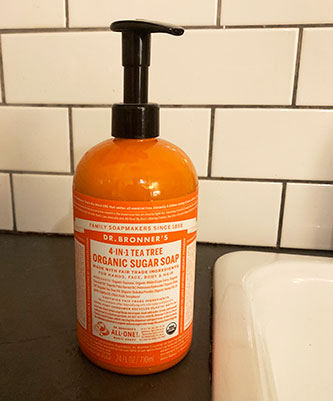My friend Beth when in nursing school took microbio lab with a professor named Dawn Holsapple. Every semester they did the same experiment — test the efficacy of household disinfectant and cleaning products, one of which was Purell.
Every time they got the same result — Purell made matters worse. Remember that this is what nurses are told will sanitize their hands as they go from bed to bed. Handwashing is an issue in nursing; a retired nurse recently told me that through her career, she washed her hands into being 10 years older than she is.

Anyway, here is the upshot of the experiment’s results, which Beth said were repeated every semester:
1. Using sanitizer means not washing.
2. Using sanitizer means not mechanically removing anything, as with soap and water. Rather, all the original material stays in place and is merely smeared around a little.
3. Purell contains polysaccharides to thicken it. This is an adhesive and it also feeds microbes. So the original microbes remain; they are fed additionally by body heat and perspiration; and the adhesive attaches new microbes as you contact other surfaces. These are fed by the product. Then those microbes are spread from contact to contact, i.e., from bed to bed.
4. Contact with alcohol kills some microbes, but it must be sustained contact with greater than 70% alcohol. Purell is not sustained contact, it is momentary contact. Sustained, depending on the pathogen, might mean 15 minutes. Or five minutes. Purell is neither.
5. BONUS: Beth Bagner read this article and adds, “Also kills healthy bacteria (probiotic) that protects your skin.” It’s the perfect product!
Side note, Purell tried to sell surgeons on its product, in lieu of the five-minute scrub. They said no way.
Now, if you think, how could the chemical manufacturer claim it works, well, PCB transformers were required by insurance companies as safety equipment well into the 1970s when it was well known (within the electrical industry) that they would not only not prevent fires, but explode.
But still, the marketing department could say, “They’re so safe the insurance company requires them,” which was the product of another dirty deal.
And on a Historical Note: Lysol was Contaminated with Dioxin
Also in disinfectant news: for many years, Lysol was contaminated with dioxin, out of the factory. The active ingredient was Santophen made by Monsanto. This is your morality tale if you don’t think that a wholesome-seeming product touted as perfectly safe just might have a problem…Lysol had a big problem, and it was advertised as safe for dogs and kids, and your kitchen and your sink…and it was spreading the Vietnam War-era toxin dioxin.
This quotation is from the appellate brief in the case Kemner v. Monsanto circa 1989. The term “2,3,7,8” is a technical nickname for dioxin, referring to the positions of the chlorine molecules in the most toxic form of the substance (a chlorine byproduct), formally called 2,3,7,8-tetrachloro-para-dioxin. It is considered the most toxic chemical known to science. Lysol was laced with 2,3,7,8 for years, possibly decades.
“Monsanto’s Santophen is the active ingredient in Lysol disinfectant and cleaning products. Monsanto’s analytical chemist, Fred Hileman, testified that Monsanto knew that Lysol is recommended for cleaning babies’ toys and for various other cleaning activities involving direct contact with the human body. Yet, there is no dioxin warning on the Lysol package. Hileman testified that he knew people who used Lysol were contacting three parts per billion of 2,3,7,8 and that 2,3,7,8 is extremely toxic. Hileman testified that he knew people were spraying their lawns with products containing Monsanto’s 2,3,7,8 and that these people didn’t even know it because they had not been told the products contained dioxin, let alone 2,3,7,8.”




1 thought on “On the Topic of Hand Sanitizer”